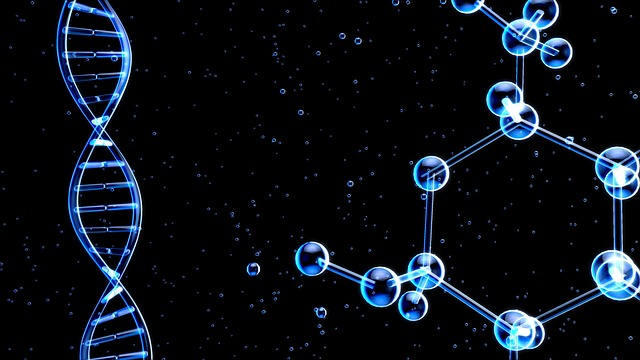NAD+, a coenzyme crucial for cell health, levels decline with age, leading to impaired function and increased mutation risk. Researchers are exploring NAD+ therapy as a potent tool for cellular repair and anti-aging by replenishing depleted NAD+ to stimulate DNA repair, gene expression regulation, and mitochondrial health, potentially slowing aging and reducing age-related diseases. While promising, NAD+ therapy requires robust clinical trials to address safety concerns and determine optimal dosing before its full potential can be unlocked as a therapeutic tool for diverse conditions.
Can NAD+ therapy hold the key to slowing down cellular aging and mutational damage? This article delves into the potential of NAD+, a vital coenzyme involved in cellular metabolism. We explore its role in maintaining cellular health, examine the emerging science behind NAD+ therapy and its anti-aging effects, and discuss its promising benefits for DNA repair and mutation mitigation. Additionally, we touch on safety considerations and future research directions for this fascinating area of study, highlighting NAD+’s potential as a powerful tool for cellular repair.
Understanding NAD+ and Its Role in Cellular Health
NAD+, or nicotinamide adenine dinucleotide, is a coenzyme found in all living cells that plays a crucial role in numerous physiological processes essential for cellular health and longevity. Acting as a key intermediary in energy production, DNA repair, and genetic expression, NAD+ serves as a vital component in the cell’s ability to maintain balance and fight off damage. As cells age, their NAD+ levels typically decline, leading to impaired function and increased vulnerability to mutations.
Researchers are exploring NAD+ therapy as a potential strategy for cellular repair and anti-aging due to its capacity to replenish these depleted levels. By enhancing NAD+ availability, this therapy aims to stimulate cellular processes involved in maintaining genetic integrity and promoting overall cell health. This approach holds promise not only for slowing down the aging process but also for mitigating the impact of mutations that can contribute to various age-related diseases.
The Science Behind NAD+ Therapy and Aging
The science behind NAD+ therapy and aging is fascinating, rooted in the fundamental processes that occur within our cells. As we age, the levels of nicotinamide adenine dinucleotide (NAD+)—a vital coenzyme involved in cellular repair—tend to decrease. This decline contributes to a range of age-related issues, from reduced energy production to increased susceptibility to mutations.
NAD+ plays a crucial role in various cellular functions, including DNA repair and the regulation of gene expression. By boosting NAD+ levels through therapy, researchers hope to mitigate some of the effects of aging. Studies suggest that NAD+ supplementation can enhance cellular resilience, promote healthy mitochondrial function, and even reverse certain age-related epigenetic changes. This potential for NAD+ to serve as a therapeutic agent in slowing down cellular aging and mutations is driving significant research in the field of anti-aging medicine.
Potential Benefits of NAD+ for Mutations and DNA Repair
NAD+ therapy holds promise in mitigating the impact of mutations and enhancing DNA repair mechanisms within cells. As an essential coenzyme, NAD+ plays a crucial role in various cellular processes, including energy production and DNA maintenance. Research suggests that boosting NAD+ levels can stimulate the activity of sirtuins, a class of proteins known for their involvement in DNA repair and gene expression regulation.
By supporting sirtuin function, NAD+ may help to counteract the accumulation of DNA damage and mutations associated with cellular aging. This is particularly significant as mutations contribute to various age-related diseases and conditions. Through its role in cellular repair, NAD+ therapy has the potential to slow down these degenerative processes, offering a promising avenue for research into anti-aging interventions and personalized medicine approaches.
Safety, Considerations, and Future Research Directions
NAD+ therapy holds promise as a potential game-changer in cellular repair and anti-aging, but it’s crucial to approach its application with caution and an eye for safety. While early studies suggest beneficial effects on slowing cellular aging and reducing mutations, rigorous clinical trials are still needed to fully understand its scope and limitations. Safety considerations include optimal dosing, long-term effects, and potential interactions with other medications. As research progresses, exploring NAD+ as a therapeutic tool in diverse conditions will shed light on its effectiveness and mechanisms of action. Future directions might involve combining NAD+ supplements with existing anti-aging strategies or investigating their synergistic effects on various age-related diseases.
NAD+ therapy presents a promising avenue for potential anti-aging and mutational benefits. By boosting cellular levels of NAD+, this therapeutic approach may help maintain optimal cellular health, support DNA repair mechanisms, and potentially slow down the aging process. While further research is needed to fully understand its effects and establish safe long-term use, the current evidence suggests that NAD+ could be a powerful tool in the quest for longevity and disease prevention. As we continue to explore NAD+’s role in cellular repair, it offers exciting possibilities for future applications in healthcare.
